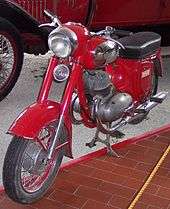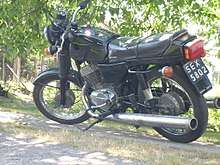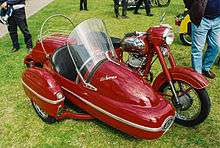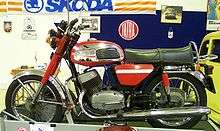Jawa 350
The Jawa 350 is a motorcycle, produced by Jawa Moto in Czechoslovakia since the 1930s until 1992 and in the Czech Republic until present. In the 1950s, with its two-stroke, air-cooled 343 cc engine it could reach speeds of 132 kilometres per hour (82 mph) and was exported into over 120 countries of the world.[1]

The Jawa 350 remains popular thanks to its dominance of the Communist Bloc countries of Eastern Europe from the 1960s to the 1990s. Competitors of that time included the German MZ (250 cc) and Simson (250 cc Sport & Awo), the Hungarian Pannonia (250 cc), the Polish Junak (350 cc) and the Soviet IZh (350 cc). This was a period before the penetration of Eastern Europe by Japanese motorcycle manufacturers. In the early nineties was made additional model line Jawa 350 type 640.
The Jawa 350 two stroke twin cylinder motorcycle is still in production, although its styling and design has changed over the years, it is almost mechanically unchanged since the 1970s, but very reliable. It is imported and sold in the UK where the two 350cc two stroke models are named the "Classic" and the "Sport". 2012 UK models are equipped with electronic ignition, electric starters and automatic pumped oil injection. They are also imported and sold in Ireland and are distributed throughout Europe.
Jawa 350 was the first foreign motorcycle, available for sale in post-WWII USSR. The other only manufactures (until 1991) were ČZ (Chezet) and Hungarian Pannónia.
The 350/640 two-stroke twin is almost mechanically unchanged since the 1970s but very reliable, it is still successfully sold mainly to the countries of Latin America.
Because the new Jawa 350 OHC meets the current EURO IV standards, it can be (unlike aged Jawa 350/640) sold in the European Union.
Versions

- 1934–1936: Jawa 350 SV - four-stroke single-cylinder motorcycle
- 1935–1946: Jawa 350 OHV - successor to 350 SV
- 1948–1956: Jawa 350 Pérák - two-stroke twin-cylinder
- 1954–1964: Jawa 350/354 - two-stroke twin-cylinder
- 1964–1974: Jawa 350/360 Automatic - two-stroke single-cylinder, with first automatic clutch in the world
- 1965–1969: Jawa 350/361 Sport - two-stroke twin-cylinder with larger 19“ wheels
- 1967–1973: Jawa 350/362 Californian - two-stroke twin-cylinder
- 1970–1972: Jawa 350/633 Bizon - two-stroke twin-cylinder
- 1973–1984: Jawa 350/634 - two-stroke twin-cylinder
- 1984–1994: Jawa 350/638 - two-stroke twin-cylinder
- 1984–1994: Jawa 350/639 - two-stroke twin-cylinder with front disc brake
- Since 1991: Jawa 350/640 - two-stroke twin-cylinder, in Style or Retro variations
- Since 2017: Jawa 350 OHC - four-stroke single-cylinder, fulfilling Euro 4
Images
.jpg) Jawa 350 SV
Jawa 350 SV- Jawa 350 OHV
.jpg) Jawa 350 Pérák
Jawa 350 Pérák Jawa 350/354 with Velorex sidecar
Jawa 350/354 with Velorex sidecar- Jawa 350/360 Automatic
- Jawa 350/361 Sport
.jpg) Jawa 350/362 Californian
Jawa 350/362 Californian- Jawa 350/633 Bizon
 Jawa 350/634
Jawa 350/634- Jawa 350/639
- Jawa 350/640 Style
 Jawa 350/640 Retro 634
Jawa 350/640 Retro 634
Jawa 350 OHC

Jawa 350 OHC is manufactured since 2017, design is trying to remind the Jawa 350/634 motorcycle from the 70s. Unlike all previous Jawa 350 motorcycles, which were two-stroke twin-cylinder, this is a four-stroke single-cylinder. For the first time in Jawa history, this model is also equipped with ABS brake assist.[2]
Design from Jawa 350 OHC Special variant is inspired by the racing motorcycle Jawa 350/673 (a special, build in three pieces in 1967). It adopts a Café racer design.[3] The third version Jawa 350 OHC Scrambler improves the off-road capabilities of the motorcycle, fuel tank is remainding the Jawa 250/353 (Kývačka).
All versions of the Jawa 350 OHC line-up are entirely based on the Chinese-Made Shineray XY400 in its respective Naked bike, Scrambler and Café Racer variants.[4]
Specifications
- Motor: air-cooled four-stroke single-cylinder with Delphi electronic injection
- Displacement: 397 cm3
- Max power: 20.4 kW @ 6500 ot./min
- Max. torque: 30.6 Nm @ 5000 ot./min
- Emission standards: Euro 4
- Wheelbase: 1420 mm
- Transmission: manual five-speed
- Wheels: Front 19", Rear 18"
- Tyres: Front 100/90/19, Rear 130/70/18
- Brakes: rear drum 160 mm, front disc 280 mm with ABS
- Dry weight: 160 kg
- Max. speed: 130 km/h[5]
- Fuel consumption: 3.2 l/100 km[6]
See also
- Jawa 250
References
- JAWA Company
- "The new Jawa 350 OHC: Affordable in Europe, unavailable in Canada". Canada Moto Guide. 1 May 2017.
- "2018 Jawa 350 Special Unveiled, Based On Jawa 350 OHC". MotorBeam. 9 May 2018.
- "Radio Prague International Article (in German)". CzechRadio. 22 Jan 2018.
- "Technická data Jawa 350 OHC: retro nebo pokrok?". Motorkari.cz (in Czech).
- "Jawa 350 OHC: retro nebo pokrok?". www.motorkari.cz (in Czech).